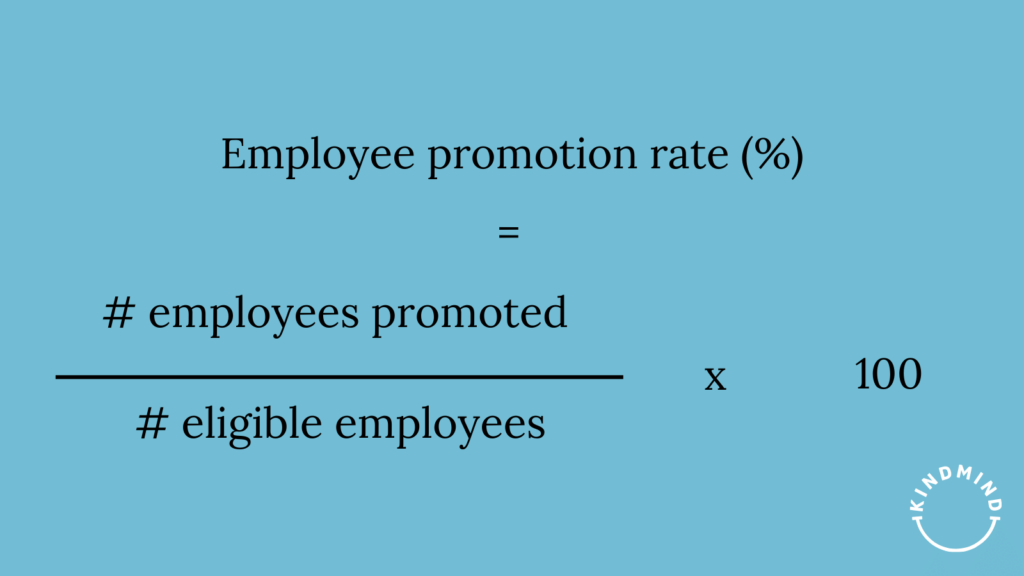One of the paths to increased employee retention is offering better career development opportunities. But how do you know if your efforts here are working? It’s all about understanding how to measure your employee promotion rate effectively.
In this Kind Mind guide, we’ll take you through how to do that, what benchmarks to aim for and how to keep improving your efforts.
Let’s dive in.
What is an employee promotion rate?
Your employee promotion rate measures the frequency or percentage of employees who are promoted to higher positions. It is loosely calculated by dividing the number of employees promoted by the total number within the organisation, usually over a specified period (we have a more specific measurement below)
Promotion rates are often used to track the effectiveness of your organisation’s talent management and development programs. A high promotion rate can indicate that your organisation successfully identifies and develops its top performers. In contrast, a low promotion rate may suggest that your organisation needs to invest more in employee development and career growth opportunities.
Why measure promotion rates at all?
There are several reasons why you may want to measure promotion rates. These include:
- Talent management – A high promotion rate may indicate that your organisation is doing an excellent job identifying and developing your top performers and promoting them into positions where they can contribute to your success.
- Employee engagement – Employees are more likely to be engaged and committed to their jobs if they believe their employer provides career advancement opportunities. Measuring promotion rates can help you identify areas where you need to improve your career development programs to increase employee engagement and retention.
- Diversity and inclusion – Measuring promotion rates can help you identify any disparities in promotion rates between different demographic groups. If certain groups are consistently underrepresented in promotions, your organisation needs to address issues in your talent management practices.
- Succession planning – Succession planning involves identifying and developing employees who have the potential to fill critical positions within your organisation in the future. Measuring promotion rates can help you identify employees who have been promoted into roles with greater responsibility and leadership potential, which can help inform succession planning efforts.
But how do you measure promotion to know if you are on track?
How to measure your employee promotion rate
So, how to measure employee promotion rate?
To measure your employee promotion rate, follow these steps:
- Define your tracking period – Choose the period you want to calculate the promotion rate. This could be a year, a quarter, or any other relevant period to your organisation.
- Define the promotion criteria – Decide what constitutes a promotion within your organisation. This could include moving to a higher job title, a higher pay grade, or assuming more significant responsibilities.
- Identify the total number of employees – Determine the total number of employees in your organisation eligible for promotion during the defined time period. This should include both full-time and part-time employees.
- Identify the number of employees promoted – Determine the number of employees promoted during the defined period. This should include only those who met the promotion criteria defined in step 2.
- Calculate the promotion rate – Divide the number of employees promoted by the total number of eligible employees, and multiply by 100 to get the promotion rate as a percentage.
Here’s the promotion rate formula

Promotion rate = (Number of employees promoted / Total number of eligible employees) x 100, by time period
For example, if your organisation has 100 eligible employees and 10 of them were promoted during the year, your promotion rate would be 10% [(10/100) x 100, in (year)].
How often should you measure promotion rates?
The frequency of measuring promotion rates will depend on your organisation’s goals, resources, and the specific KPIs being used. However, measuring promotion rates at least annually is generally recommended to get a comprehensive view of an organisation’s talent management practices.
However, some businesses may measure promotion rates more frequently, such as quarterly or bi-annually, to monitor progress and promptly adjust their talent management strategy.
Ultimately, the frequency of measuring your promotion rates will depend on your organisation’s specific needs and priorities. It’s essential to balance measuring promotion rates often enough to stay informed and not measuring them so frequently that it becomes burdensome or distracts from other important issues.
What is a good promotion rate benchmark?
There is no one-size-fits-all benchmark for a good promotion rate, as it can vary depending on factors such as the industry, company size, and the types of jobs within the organisation. However, some general guidelines can be helpful.
According to the Office for National Statistics, the average promotion rate in the UK was 19.58% between 2003 and 2017. Those most likely to receive a promotion were aged between 16 and 29.
Whilst the gender split was almost even in promotion opportunities, the industry that employees worked in mattered. Those with higher-than-average promotion numbers included:
- Professional, scientific and technical
- Accommodation and food services
- Financial and insurance
- Electricity, gas, air cond supply
- Real estate
- Education
- And human health and social work activities
Those with far lower-than-average rates included:
- Agriculture, forestry and fishing
- Transport and storage
- Households as employers
- And other services
It’s important to note that a high promotion rate is only sometimes an indicator of good talent management practices. A very high promotion rate could indicate a need for career growth opportunities within the organisation if employees are promoted frequently to keep them engaged. On the other hand, a low promotion rate may suggest that the organisation needs to be more effectively identifying and developing its top performers.
Related employee promotion rate KPIs
When you are considering rates of promotion within your business, it is vital to understand if other factors may be affecting your talent management practices. Here are some common KPIs to consider:

Time to promotion
This KPI measures the average length of time it takes for an employee to be promoted within your organisation. It can help identify any potential roadblocks or barriers to career growth within your business.
Diversity in promotions
This is the percentage of promotions awarded to employees from diverse backgrounds. It can track progress in promoting diversity and inclusion within your business.
Succession planning effectiveness
You measure your effectiveness by calculating the percentage of key leadership positions filled by internal candidates. A high rate of internal promotions into leadership positions can indicate effective succession planning.
Promotions per employee
This KPI measures the average number of promotions per employee over a given period. It can help identify high-potential employees and assess the effectiveness of talent development programs.
By tracking these KPIs over time, you can gain insights into the effectiveness of your talent management practices and identify areas to support employee career growth and development.
How to start improving your employee promotion rate
Improving employee promotion rates is a complex process involving factors such as performance, skills, qualifications, potential, and organisational needs. Here are some steps you can take to start improving your employee promotion rates:
- Establish clear criteria – Define clear and objective promotion criteria aligned with your company’s goals and values. These criteria should be communicated to employees to help them understand what they need to do to be considered for promotion.
- Create a career development plan – Work with employees to create a career development plan that outlines their goals, strengths, and areas for improvement. This plan should include training and development opportunities to help employees acquire the skills and experience needed for promotion.
- Provide regular feedback – Schedule regular check-ins with employees to provide feedback on their performance, progress, and areas for improvement. This feedback should be specific, constructive, and focused on helping employees develop the skills and experience needed for promotion.
- Offer training and development opportunities – Provide employees with training and development opportunities to help them acquire the skills and experience needed for promotion. These opportunities could include workshops, conferences, mentoring, or job shadowing.
- Encourage internal mobility – Create a culture that encourages internal mobility by promoting from within and offering employees opportunities to move to different departments or roles. This will help employees develop a broader range of skills and experience, which will make them more competitive for promotion.
- Offer wellness provision – Deliver ongoing support through wellness plans focusing on healthy and positive work cultures, increasing engagement and, most importantly, encouraging staff through promotional transitions. Most businesses forget this, but here at Kind Mind, we think there’s a great deal of benefit to remembering it!
- Ensure fairness and transparency – Ensure the promotion process is fair, transparent, and merit-based. Avoid favouritism or nepotism, and ensure that all employees have an equal opportunity to be considered for promotion.
Remember that improving employee promotion rates is a long-term process that requires a commitment to career development, training, and communication. By creating a supportive and growth-oriented work environment, you can help employees develop the skills and experience they need to advance in their careers.
Good luck.
Are you looking for more guides on HR benchmarks? Read our latest articles here.






